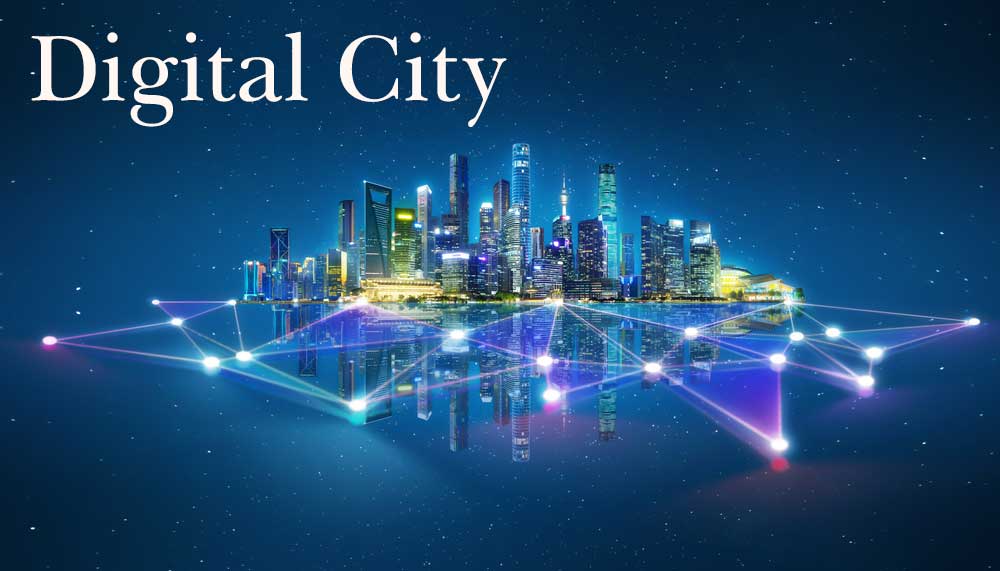In the 21st century, technology has revolutionized the way we live, work, and interact with each other. One of the most significant changes brought about by technology is the rise of digital cities. A digital city is a smart city that leverages technology to improve the lives of its citizens, streamline processes, and enhance sustainability.
The concept of a Digital City
The first question that comes to mind after hearing the concept of aDigital City is, what is the concept of a Digital City?
The answer is that there is no universally accepted definition of a Digital City. This interpretation has different meanings for each city or country, depending on the level of development, willingness to change and reform, and available resources.
Standard definitions of the Digital City concept
Global standards have provided several definitions of theconcept of the Digital City.
To learn more about it, here are some examples of the most important ones.
Digital City concept according to ITU-T standard
The ITU-T standardization organization defines a sustainable Digital City as a city that, taking into account the needs of the current and future generations, and taking into account economic, social, and environmental aspects, uses ICT and other tools to improve the quality of life and increase the efficiency of urban services and creating competition uses.
Digital City concept in SAC standard
SAC definesthe Digital City as a new concept and model that uses the new generation of technologies and services in the field of ICT (Fava), such as the Internet of Things, cloud computing, and big data to facilitate the process of planning, infrastructure, and management of smart and dynamic services in cities. Based on this definition, the development of smart cities can contribute to synchronous development in all sectors, industrialization, urbanization, agricultural modernization, and the sustainable development process of cities.
This organization presents the following major goals for making cities smarter:
- facilitating the provision of public services;
- tact in urban management;
- infrastructure intelligence;
- The liveliness of the living environment (which will somehow show itself in the service delivery layer).
GSMA definition of the Digital City concept
According to the GSMA definition,the concept of a Digital City broadly uses ICT, particularly mobile networks, to improve citizens’ quality of life in a sustainable manner. Therefore, aDigital Citycollects and processes distributed data sets from intelligently connected infrastructure, people, and equipment. Citizens will have access to the services provided in all situations and at any time, and in this way, improving the efficiency of municipal services, saving fuel, and being more prepared against natural disasters – due to faster notification – will be achieved.
Three basic steps in making cities digital
According to the definitions of the concept of a Digital City and according to the model presented by Smart Cities Council, three basic steps in making a city smart can be shown as shown in the figure below.
- Data collection (Collect): Smart equipment (sensors, etc.) are widely calculated and logically placed in the city to measure and monitor various characteristics. For example, smart metering equipment can measure electricity, gas, and water usage with high accuracy, and smart traffic sensors can report real-time information on road conditions and possible congestion. Automatic weather stations can also provide real-time weather reports to citizens. In addition to the mentioned cases, smartphones that are available to citizens can also collect user information such as location, speed, and range status – of course, with the user’s permission.
- Communicate: Once the data is collected, it must be communicated to the control center or other equipment. This operation is possible either wired – optical fiber – or wireless. The ultimate goal is connecting people and equipment everywhere, which requires interactive functionality.
- Data analysis (Crunch): After receiving the transmitted data, data processing operations are performed in the control center with the following goals:
Transforming “information” into “knowledge” about existing conditions: the software infrastructureof the Digital City concept monitors and analyzes a huge flow of input data in a way understandable to humans. For example, aDigital City operation center can monitor all emergencies, such as police, fire, ambulance, traffic situation, etc., and, if necessary, provide appropriate information about the prevailing conditions.
Improvement of conditions and prediction of future conditions: by using the knowledge acquired in the previous stage and the processing power of computers, the performance of complex systems (of which most urban systems are an example) is optimized.
For example, we can mention balancing the supply and demand of the power grid, directing traffic to control congestion, reducing fuel consumption by choosing the right route, and many other benefits. In addition to the above-mentioned, the most attractive purpose of processing the received data is to predict the future situation.
Operational center of the Digital City of Rio de Janeiro
As an example, in the operational center of the Digital City of Rio de Janeiro, data from 30 different areas of the city, including water, energy, weather conditions, etc., are received and processed by supercomputers. In addition to informing about the current conditions, floods, and storms are also predicted in this center. Finally, the predictions are reported to the relief teams so that the necessary measures can be taken at the right time.
According to what was said, although a precise and comprehensive definition forthe concept of a Digital City cannot be provided, a Digital City can be considered a system of other urban systems (such as water, electricity, transportation, emergencies, etc.), which every Which influence the other. By collecting and processing the data of these systems, we can have information about the current situation and predictions of the future situation, which leads to the sustainability and vitality of the city.
To make a difference between electronic services (such as information portals, online receipt of tolls, etc.) and smart services, we often consider things based on real-time information and their analysis to be fully interactive. Therefore, although urban electronic services and automation can also be considered basic examples of smart urban services, the use of new ICT technologies (Internet of Things, big data, etc.) is the key difference between future smart cities and current electronic cities.
Digital City and Technology
Digital cities will use data and technology to improve the quality of life for citizens, streamline processes, and enhance sustainability. Here are some examples of how digital cities will be:
- Connected Infrastructure: In a digital city, all infrastructure will be connected through a digital network, allowing for the collection and analysis of data to make informed decisions and provide better services to citizens. For example, traffic lights will communicate with cars, optimizing traffic flow and reducing congestion.
- Smart Energy Systems: Digital cities will use smart energy systems to optimize energy usage, reduce waste, and increase efficiency. For example, buildings will be equipped with sensors and automation to improve energy efficiency, and renewable energy sources such as solar and wind will be integrated into the city’s energy grid.
- Intelligent Transportation Systems: Digital cities will use intelligent transportation systems to reduce congestion, improve safety, and decrease travel times. For example, autonomous vehicles will transport citizens, and real-time traffic information will help drivers make informed decisions about their routes.
- Citizen Engagement: Digital cities will enable citizens to participate in decision-making and hold their elected representatives accountable through digital platforms such as mobile apps and websites. Citizens can provide feedback on city services, report issues, and access information about city government.
- Sustainability: Digital cities will enhance sustainability by reducing waste and optimizing the use of resources. For example, waste management systems will be optimized to reduce waste and increase recycling, and water usage will be monitored and optimized to conserve water.
Digital City and Future
As we look to the future, digital cities will play a pivotal role in shaping human life, and in this article, we will explore the impact of digital cities on the future.
- First, digital cities will transform the way we interact with our surroundings. As technology becomes more integrated into our daily lives, it will become easier for us to communicate with the places we inhabit. Digital sensors and smart devices will allow us to gather real-time data about our environment, such as air quality, traffic flow, and energy consumption. This will enable us to make informed decisions about how we use our resources and interact with our environment.
- Second, digital cities will create new opportunities for innovation and entrepreneurship. As more and more people migrate to urban areas, the demand for smart technologies will increase. This will create a fertile ground for start-ups and entrepreneurs to develop innovative solutions that can improve the lives of city dwellers. For example, smart transportation systems, such as autonomous vehicles, will create new business opportunities for companies developing and implementing these technologies.
- Third, digital cities will enhance the sustainability of our urban areas. The rise of digital cities will make it easier to manage resources and reduce waste. Smart grids, for example, will allow us to generate, distribute, and use energy more efficiently. This will reduce our carbon footprint and create a more sustainable future.
- Fourth, digital cities will transform the way we work. As remote work becomes more common, digital cities will enable people to work from anywhere. Smart devices will allow us to connect to our colleagues and clients from any location. This will create new opportunities for collaboration and innovation and improve work-life balance.
- Fifth, digital cities will create new challenges and opportunities for governance. As technology becomes more integrated into our daily lives, governments will need to adapt their policies and regulations to ensure the safety and well-being of citizens. This will require new forms of governance that are more responsive to the needs and concerns of citizens. At the same time, digital cities will create new opportunities for citizen engagement and participation. For example, citizens can use digital platforms to voice their opinions, participate in decision-making, and hold their elected representatives accountable.
Digital City and AI
The relationship between digital cities and artificial intelligence (AI) is a strong one. AI can be used in digital cities to analyze data, optimize services, and automate processes, which can lead to a more efficient and sustainable urban environment. In this article, we will explore the relationship between digital cities and AI and its potential impact on the future of urban living.
- First, AI can be used in digital cities to analyze large amounts of data from various sources to identify patterns and trends. For example, sensors installed throughout the city can collect data on traffic patterns, air quality, energy usage, and waste management. AI algorithms can then process this data to identify areas where improvements can be made, such as reducing traffic congestion or optimizing energy usage in buildings. This can lead to more efficient and effective urban planning, as city officials can make data-driven decisions.
- Second, AI can be used to optimize services in digital cities. For example, AI-powered chatbots can be used to answer citizen inquiries and provide information about city services. This can reduce the workload of city staff and improve the speed and accuracy of responses to citizen inquiries. Additionally, AI can be used to optimize public transportation systems by predicting demand and adjusting schedules and routes accordingly. This can lead to reduced waiting times for citizens and a more efficient transportation system overall.
- Third, AI can be used to automate processes in digital cities. For example, AI-powered robots can be used for waste management, cleaning, and maintenance tasks. This can reduce the workload of city staff and free up resources to be used elsewhere. Additionally, AI-powered systems can be used to monitor and maintain the city’s infrastructure, such as bridges, tunnels, and water systems. This can improve the safety and reliability of these critical systems.
- Fourth, AI can be used to enhance sustainability in digital cities. For example, AI-powered systems can be used to monitor and optimize energy usage in buildings, reducing waste and saving costs. Additionally, AI can be used to optimize waste management systems, reducing the amount of waste sent to landfills and increasing recycling rates. AI can also be used to monitor air quality and reduce pollution in the city.
- Finally, AI can be used to enhance citizen engagement in digital cities. For example, AI-powered chatbots and virtual assistants can be used to provide citizens with information about city services and respond to citizen inquiries. Additionally, AI-powered systems can be used to predict and prevent crime, improving the safety and security of citizens.
The potential impact of AI on the future of urban living is significant. As the world becomes more urbanized, with over 68% of the global population projected to live in cities by 2050, the need for efficient and sustainable urban environments is becoming more urgent. AI can help meet this need by enabling cities to make data-driven decisions, optimize services, and enhance sustainability.
One of the key advantages of AI in digital cities is its ability to process and analyze large amounts of data in real-time. This allows cities to respond quickly to changes and adjust services and infrastructure accordingly. For example, AI-powered traffic management systems can quickly adjust traffic light timings to reduce congestion in real-time. This can improve traffic flow, reduce travel times, and lower emissions.
In addition, AI can help cities reduce waste and increase recycling rates. AI-powered waste management systems can sort and separate different types of waste, increasing recycling rates and reducing the amount of waste sent to landfills. AI can also be used to optimize the collection routes of waste management trucks, reducing fuel consumption and emissions.
Another area where AI can have a significant impact on urban living is public safety. AI-powered systems can be used to monitor public spaces and predict potential crime. This can improve the safety of citizens and reduce the workload of law enforcement agencies. AI can also be used to monitor and respond to emergency situations, such as natural disasters or terrorist attacks. This can help reduce the damage caused by such events and improve the response time of emergency services.
However, the use of AI in digital cities also presents challenges and risks that need to be addressed. One of the primary concerns is data privacy and security. The collection and use of large amounts of data can raise privacy concerns, and cities need to ensure that they are using data ethically and transparently. In addition, AI-powered systems are vulnerable to hacking and cyber attacks, and cities need to implement robust security measures to protect their systems and data.
Another concern is the potential impact of AI on employment. As AI is used to automate processes and services, it has the potential to displace human workers. Cities need to ensure that the implementation of AI in digital cities is done in a way that balances the benefits of automation with the need to protect jobs and support the workforce.
Another challenge of using AI in digital cities is the need for robust and reliable infrastructure. AI systems require significant computing power, and cities need to have the necessary hardware and network infrastructure to support these systems. This can be a significant investment for cities, and it is important to ensure that the benefits of AI outweigh the costs.
Furthermore, the adoption of AI in digital cities needs to be accompanied by appropriate policies and regulations. Cities need to establish guidelines for the ethical use of AI and ensure that the technology is used in a transparent and accountable manner. This includes ensuring that algorithms are fair and unbiased, and that citizens have access to the data used by AI systems.
Despite these challenges, the potential benefits of AI in digital cities are significant. AI can help create more efficient, sustainable, and livable urban environments. As cities continue to grow and evolve, the use of AI is likely to become increasingly important in enabling them to meet the needs of their citizens.
One area where the impact of AI in digital cities is likely to be significant in the future is in the development of autonomous vehicles. As self-driving cars become more widespread, AI will be essential in enabling them to navigate safely and efficiently in urban environments. This will require the integration of AI-powered traffic management systems, as well as the development of AI algorithms that can anticipate and respond to changing traffic conditions in real-time.
Another area where the impact of AI in digital cities is likely to be significant is in the development of smart buildings. AI can be used to optimize energy usage in buildings, reducing waste and saving costs. It can also be used to monitor and maintain building systems, ensuring that they are operating efficiently and effectively. This can lead to significant cost savings for building owners, as well as improvements in the quality of life for building occupants.



